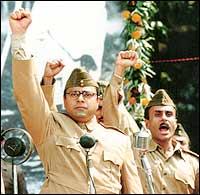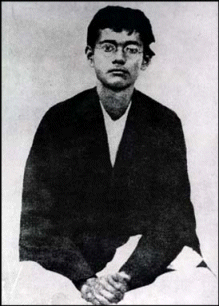
Netaji Subhash Chandra Bose, a prominent leader of the Indian independence movement, was born on January 23 1897 in Cuttack, Orissa. Netaji was elected the president of Indian National Congress, but due to ideological conflicts with Mahatma Gandhi, he established a separate political party, the All India Forward Bloc and continued to call for the full and immediate independence of India from British rule. He was imprisoned by the British authorities 11 times. Later, he formed the Azad Hind Government in exile, regrouped and led the Indian National Army. Netaji is presumed to have died on 18 August 1945 in a plane crash over Taiwan. However, there are few contradictory evidences regarding his death in the accident.

Nethaji Subhash Chandra Bose was born on January 23, 1897 at Cuttack, in Orissa. He was the sixth son of Janakinath and Prabhavati Bose.
Subhash was an excellent student and after school joined the Presidency College, Calcutta, where he studied philosophy, a subject he was interest in.
As a young boy Subhash felt neglected among his 8 siblings. At his English school he suffered under the discrimination faced by Indians which made him even sadder.


Subhash Chandra Bose was a very intelligent and sincere student but never had much interest in sports. He passed his B.A. in Philosophy from the Presidency College in Calcutta. He was strongly influenced by Swami Vivekananda's teachings and was known for his patriotic zeal as a student. He also adored Vivekananda as his spiritual Guru.
Known as Netaji (leader), Mr. Bose was a fierce and popular leader in the political scene in pre-independence India . He was the president of the Indian National Congress in 1937 and 1939, and founded a nationalist force called the Indian National Army. He was acclaimed as a semigod, akin to the many mythological heroes like Rama or Krishna, and continues as a legend in Indian mind.
Subhas Chandra was born on January 23rd 1897 in Cuttack (in present day Orissa) as the ninth child among fourteen, of Janakinath Bose, an advocate, and Prabhavatidevi, a pious and God-fearing lady. A brilliant student, he topped the matriculation examination of Calcutta province and passed his B.A. in Philosophy from the Presidency College in Calcutta. He was strongly influenced by Swami Vivekananda's teachings and was known for his patriotic zeal as a student. His parents' wishes kept him away from the Indian freedom struggle and led him into studies for the Indian Civil Service in England. Although he finished those examinations also at the top of his class (4th), he could not complete his aprecentship and returned to India, being deeply disturbed by the Jallianwalla Bagh massacre. He came under the influence of Mahatma Gandhi and joined the Indian National Congress (a.k.a. Congress). Gandhiji directed him to work with Deshbandhu Chittaranjan Das, the Bengali leader whom Bose acknowledged as his political guru.

Bose wanted to free India from the Eastern front. He had taken care that Japanese interference was not present from any angle. Army leadership, administration and communications were managed only by Indians. Subhash Brigade, Azad Brigade and Gandhi Brigade were formed. INA marched through Burma and occupied Coxtown on the Indian Border. A touching scene ensued when the solders entered their 'free' motherland. Some lay down and kissed, some placed pieces of mother earth on their heads, others wept. They were now inside of India and were determined to drive out the British! Delhi Chalo (Let's march to Delhi) was the war cry.
The bombing of Hiroshima and Nagasaki changed the history of mankind. Japan had to surrender. Bose was in Singapore at that time and decided to go to Tokyo for his next course of action. Unfortunately, the plane he boarded crashed near Taipei and he died in the hospital of severe burns. He was just 48.
The Indian people were so much enamored of Bose's oratory and leadership qualities, fealressness and mysterious adventures, that he had become a legend. They refused to believe that he died in the plane crash. The famous Red Fort trial wherein Bose's generals and the INA officers were tried, became landmark events. Initially, the British Government thought of a court-martial, but there was a countrywide protest against any kind of punishment. For common Indians, Axis and Allied powers hardly mattered, but they could not tolerate punishment of fellow countrymen who were fighting for freedom. The British Government was in no position to face open rebellion or mutiny and a general amnesty for INA soldiers was declared.
While Bose's approach to Indian freedom continues to generate heated debate in the Indian society today, there is no denying of his burning patriotism, his tireless efforts to free India from inside and outside and his reckless adventures in trying to reach his goals. His exploits later became a legend due to the many stories carried by the disbanded INA soldiers who came from every nook and corner of our great country.
Had he lived, Subhas Chandra Bose could have given a new turn to Independent India's political history. But he lives on eternally in the Indian mind, more famous after his death.

No comments:
Post a Comment